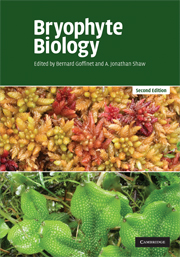Book contents
- Frontmatter
- Contents
- List of contributors
- Preface
- 1 Morphology and classification of the Marchantiophyta
- 2 Morphology, anatomy, and classification of the Bryophyta
- 3 New insights into morphology, anatomy, and systematics of hornworts
- 4 Phylogenomics and early land plant evolution
- 5 Mosses as model organisms for developmental, cellular, and molecular biology
- 6 Physiological ecology
- 7 Biochemical and molecular mechanisms of desiccation tolerance in bryophytes
- 8 Mineral nutrition and substratum ecology
- 9 The structure and function of bryophyte-dominated peatlands
- 10 Population and community ecology of bryophytes
- 11 Bryophyte species and speciation
- 12 Conservation biology of bryophytes
- Index
- References
11 - Bryophyte species and speciation
Published online by Cambridge University Press: 06 July 2010
- Frontmatter
- Contents
- List of contributors
- Preface
- 1 Morphology and classification of the Marchantiophyta
- 2 Morphology, anatomy, and classification of the Bryophyta
- 3 New insights into morphology, anatomy, and systematics of hornworts
- 4 Phylogenomics and early land plant evolution
- 5 Mosses as model organisms for developmental, cellular, and molecular biology
- 6 Physiological ecology
- 7 Biochemical and molecular mechanisms of desiccation tolerance in bryophytes
- 8 Mineral nutrition and substratum ecology
- 9 The structure and function of bryophyte-dominated peatlands
- 10 Population and community ecology of bryophytes
- 11 Bryophyte species and speciation
- 12 Conservation biology of bryophytes
- Index
- References
Summary
Introduction
The three lineages of bryophytes, mosses, liverworts, and hornworts, compose successful groups of early embryophytes. The mosses are estimated to include some 12 700 species (Crosby et al. 2000), the liverworts approximately 6000–8000 extant species (Crandall-Stotler & Stotler 2000, Chapter 1, this volume), and the hornworts about 100–150 species (Chapter 3, this volume). Mosses are comparable in species richness to the monilophytes, which are estimated to include about 11 500 species (Pryer et al. 2004). Among the extant land plants, therefore, only the angiosperms are currently more species-rich than are the bryophytes.
It is often stated that bryophytes are most diverse in the tropics and fit the general pattern found in many groups of organisms, with increasing species richness toward the equator (Rosenzweig 1995). However, a quantitative analysis of latitudinal diversity patterns in the mosses failed to detect any such latitudinal gradient, except perhaps a weak one in the Americas (Shaw et al. 2005a). It appears that liverwort diversity is highest at moderate to high latitudes of the Southern Hemisphere, although one family, the Lejeuneaceae, is hyperdiverse in wet tropical forests of both the New and Old Worlds (Gradstein 1979).
The fossil record for mosses, liverworts, and hornworts is too incomplete to assess whether these groups were more or less diverse in the geological past (Miller 1984, Oostendorp 1987).
- Type
- Chapter
- Information
- Bryophyte Biology , pp. 445 - 486Publisher: Cambridge University PressPrint publication year: 2008
References
- 4
- Cited by



